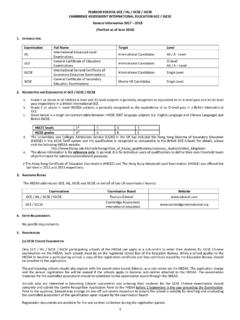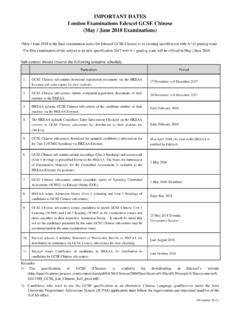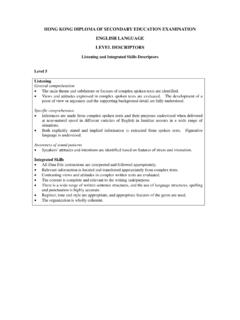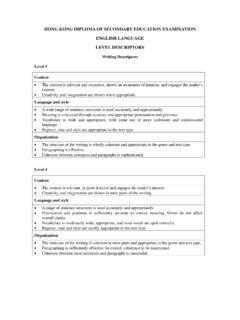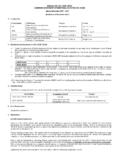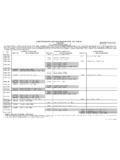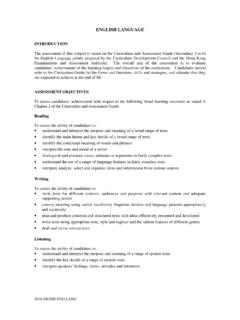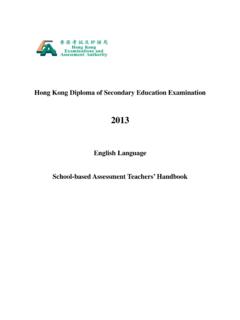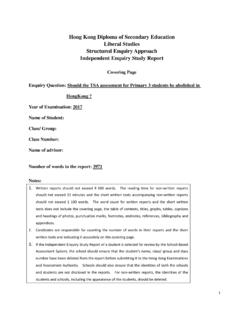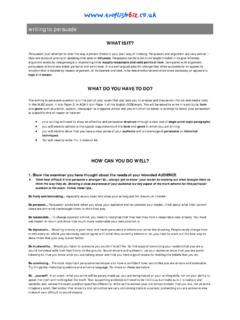Transcription of Language Proficiency Assessment for Teachers (English ...
1 Contents Page INTRODUCTION 1. Objective 1. The LPATE 1. Proficiency Levels 2. READING 4. General Description 4. Test Taking Strategies 4. Sample Reading Paper 5. Sample Reading Paper Suggested answers 21. Scores and Proficiency Levels for Sample Reading Paper 24. WRITING 25. General Description 25. Part 1: Composition 25. Test Taking Strategies for Part 1 25. LPATE Performance Descriptors: Writing (Part 1: Composition) 26. Sample Writing (Part 1) Task 27. Sample Writings and Assessment 28. Part 2: Correcting and Explaining Errors/Problems in a Student's Composition 32. Test Taking Strategies for Part 2 32.
2 Sample Writing (Part 2) Tasks 33. Sample Writing (Part 2) Tasks Suggested answers 39. Scores and Proficiency Levels for Sample Writing (Part 2) Tasks 40. LISTENING 41. General Description 41. Test Taking Strategies 41. Sample Listening Paper 43. Sample Listening Paper Suggested answers 65. Scores and Proficiency Levels for Sample Listening Paper 68. SPEAKING 69. General Description 69. Test Taking Strategies 70. LPATE Performance Descriptors: Speaking 71. Sample Speaking Paper 74. CLASSROOM Language Assessment 78. General Description 78. Advice to Candidates 78. LPATE Performance Descriptors: Classroom Language Assessment 80.
3 ACKNOWLEDGEMENTS 82. INTRODUCTION. This Handbook gives an overview of the Language Proficiency Assessment for Teachers (English Language ) (LPATE) for candidates, administrators and other users. It outlines the key features of the LPATE from the 2011 administration onward and replaces the Language Proficiency Assessment for Teachers (English Language ) Handbook (October 2007). The Handbook contains a description of each component of the LPATE, sample papers, suggested answers and exemplar performances to help candidates to better understand the requirements of the 2011 and subsequent administrations of the LPATE.
4 The Handbook is accompanied by a CD containing a recording of the sample Listening paper and a DVD containing recordings of sample performances of the Speaking paper and the Classroom Language Assessment . Objective The objective of the LPATE is to provide an objective reference against which the Language Proficiency of primary/secondary English Teachers can be gauged. The LPATE The LPATE is a standards referenced Assessment in which the same sets of scales and descriptors as well as criteria for determining grades are applied to all candidates, candidates are not compared against each other.
5 Candidates must satisfy the entry requirements as stipulated by the Education Bureau and the Hong Kong Examinations and Assessment Authority. The five papers in the LPATE are: 1. Reading 2. Writing 3. Listening 4. Speaking 5. Classroom Language Assessment Participating candidates are assessed by three pen and paper tests, a speaking Assessment , and in their use of classroom Language . Please refer to the respective sections for detailed explanations of the specific Language skill areas to be assessed. Candidates can apply to sit up to five papers in each administration of the Assessment .
6 1. Proficiency Levels In the Assessment of Writing (Part 1: Composition), Speaking and Classroom Language , the assessors use scales and descriptors. The Assessment of performance in these three papers involves the use of more than one scale. When using a scale, an assessor will award, based on the performance of a candidate, a number from 1 to 5, indicating the ability level demonstrated on a scale. Level 5 is the highest Proficiency level a candidate can attain on a scale, and Level 1 the lowest. A candidate is considered to have reached the required level of Proficiency ( Level 3) in each of the above papers / part of the paper if he or she has attained at least ' or above on any one scale and 3' or above on all other scales in the relevant papers.
7 For each of the scales in papers involving two assessors, it is possible for a non integer score ( ') to be awarded to a candidate because the 1. Proficiency level awarded is the average of the grades from two assessors. For the Assessment of Reading, Writing (Part 2: Correcting and Explaining Errors/Problems in a Student's Composition) and Listening, which does not involve the use of scales and descriptors (see Note below), a candidate is considered to have satisfied the Language Proficiency requirement if he or she has achieved an overall 3' or above in each of the relevant papers / part of the paper.
8 The Language Proficiency requirement for each paper can thus be summarised as below: Paper Language Proficiency Requirement Reading Level 3 or above Composition At least ' or above on any one scale and 3' or above on the other two scales AND Correcting and 3' or above on each scale Writing Explaining Errors/Problems in a Student's Composition Listening Level 3 or above Speaking At least ' or above on any one scale and 3' or above on all the other scales Classroom Language Assessment At least ' or above on any one scale and 3' or above on all the other scales Note: Scales and descriptors are not used in the Assessment of Reading, Writing (Part 2: Correcting and Explaining Errors/Problems in a Student's Composition) and Listening, because these components are made up of relatively large sets of discrete items.
9 The Proficiency levels to be 1. The Writing (Part 1: Composition) component employs Rasch modelling techniques in order to arrive at a Fair Average score for each candidate on each scale of performance. The Rasch model takes into account factors such as task difficulty and assessor characteristics. The fair averaging procedure may also give rise to non integer scores. 2. awarded are arrived at empirically by using two methods: Rasch analysis and expert judgement. Rasch analysis is a statistical method that provides a common metric to describe both the level of difficulty of test items and the performance of candidates.
10 (This method enables consistent measurement independent of variations in the ability of test takers and the difficulty level of different test items used in different sittings of Assessment .) Expert judgement involves experts in the field reviewing the test content in combination with the information about item and test difficulty provided by the Rasch statistical analysis in order to relate marks on the test to levels of performance and ability. 3. READING. READING General Description Paper format The Reading paper consists of three parts. Timing 1 hour 30 minutes No. of questions 40 50 question types Including but not limited to: open ended short answer, sentence.
